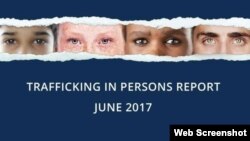According to the latest human trafficking report published by the US Department of State, Iran has been a source, transit site and destination country for men, women and children subjected to human trafficking.
The report was published on June 27 in a ceremony with Secretary Rex Tillerson and President Donald Trump present.
While the Iranian tier in the human trafficking ranking has remained unchanged compared with last year, it is stated in the report that organized groups subject Iranian women, boys and girls to human trafficking.
The United Arab Emirates, Iraqi Kurdistan Region, Pakistan, Afghanistan and Europe are reportedly places where Iranian nationals are trafficked and recruited as sex workers.
Another aspect brought to light in the report is the fate awaiting younger Iranian girls trafficked to the aforementioned countries.
“Iranian girls between the ages of 13 and 17 are targeted by traffickers for sale abroad; younger girls may be forced into domestic service until their traffickers consider them old enough to be subjected to child sex trafficking”, the report states.
Dubai has long been a hot-spot for Iranian sex tourism: the concentration of businesses and demand from oil-rich Persian Gulf-states has attracted a wave of sex workers from Iran. Consequently, in 2016, there was a hike in the number of sex workers arriving in Dubai, according to the report. Some of these individuals are reportedly victims of human trafficking.
Sulaymaniyah, in Iraqi Kurdistan, is another destination for Iranian victims of human trafficking, according to the report. Poverty, sexual discrimination and addiction are reportedly a few of the reasons for the hike in the number of Iranian nationals recruited to work in the sex industry and being targeted by trafficking organizations.
The human trafficking report of the US State Department mentioned what is referred to as “short-term” marriages – a term often used in the Shi'ite Islam – as another form of commercial sexual exploitation increasingly practiced in Iran. Such bonds last from one hour to one week and are strongly supported by the conservative wing of the Islamic Republic of Iran.
Another form of human trafficking highlighted in the report is the “[coercion] of male Afghan migrants and registered refugees, including boys as young as 12, to fight in Syria”. The report accuses the Islamic Republic and its strong military empire, the Iranian Revolution Guards’ Corps (IRGC), of recruiting Afghan migrants by threatening them with arrest and deportation.
Death reports of these recruits regularly appear in Iranian media. The country's officials say the foreign citizens are "volunteer forces" who ask to be sent to Syria and Iraq as defenders of the Shi'ite holy sites.
Elsewhere in the report, it is stated that the Islamic Republic of Iran has agreed to improve cooperation with a few countries in the region to combat trafficking but has not disclosed details of such cooperation. As a result, the report concludes, Iran remains an important place as far as human trafficking is concerned: a source, a transit and a destination.




